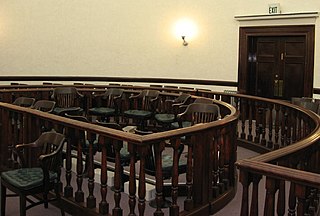Related Research Articles

The Sixth Amendment to the United States Constitution sets forth rights related to criminal prosecutions. It was ratified in 1791 as part of the United States Bill of Rights. The Supreme Court has applied all but one of this amendment's protections to the states through the Due Process Clause of the Fourteenth Amendment.

A jury is a sworn body of people (jurors) convened to hear evidence, make findings of fact, and render an impartial verdict officially submitted to them by a court, or to set a penalty or judgment.
Voir dire is a legal term for procedures during a trial that help a judge decide certain issues:
Batson v. Kentucky, 476 U.S. 79 (1986), was a landmark decision of the United States Supreme Court ruling that a prosecutor's use of a peremptory challenge in a criminal case—the dismissal of jurors without stating a valid cause for doing so—may not be used to exclude jurors based solely on their race. The Court ruled that this practice violated the Equal Protection Clause of the Fourteenth Amendment. The case gave rise to the term Batson challenge, an objection to a peremptory challenge based on the standard established by the Supreme Court's decision in this case. Subsequent jurisprudence has resulted in the extension of Batson to civil cases and cases where jurors are excluded on the basis of sex.
A legal remedy, also referred to as judicial relief or a judicial remedy, is the means with which a court of law, usually in the exercise of civil law jurisdiction, enforces a right, imposes a penalty, or makes another court order to impose its will in order to compensate for the harm of a wrongful act inflicted upon an individual.
The right of peremptory challenge is a legal right in jury selection for the attorneys to reject a certain number of potential jurors or judges without stating a reason. The idea behind peremptory challenges is that if both parties have contributed in the configuration of the jury, they will find its verdict more acceptable. The use of peremptory challenges is controversial as some feel it has been used to undermine the balanced representation on a jury which would occur using random selection. Many jurisdictions limit or prohibit peremptory challenges.
A struck jury is a multi-step process of selecting a jury from a pool. First potential jurors are eliminated for hardship. Second jurors are eliminated for cause by conducting voir dire until there is a pool available that is exactly the size of the final jury plus the number of peremptory challenges available to each side. Then the two sides exercise their peremptory challenges on the remaining pool, usually alternating. This procedure "has its roots in ancient common law heritage".
Jury selection is the selection of the people who will serve on a jury during a jury trial. The group of potential jurors is first selected from among the community using a reasonably random method. Jury lists are compiled from voter registrations and driver license or ID renewals. From those lists, summonses are mailed. A panel of jurors is then assigned to a courtroom.
Miller-El v. Dretke, 545 U.S. 231 (2005), is a United States Supreme Court case that clarified the constitutional limitations on the use by prosecutors of peremptory challenges and of the Texas procedure termed the "jury shuffle."
People v. LaValle, 3 N.Y.3d 88 (2004), was a landmark decision by the New York Court of Appeals, the highest court in the U.S. state of New York, in which the court ruled that the state's death penalty statute was unconstitutional because of the statute's direction on how the jury was to be instructed in case of deadlock. New York has since then abandoned the death penalty, as the law has not been amended.
Jury duty or jury service is a service as a juror in a legal proceeding. Different countries have different approaches to juries. Variations include the kinds of cases tried before a jury, how many jurors hear a trial, and whether the lay person is involved in a single trial or holds a paid job similar to a judge, but without legal training.
Scientific jury selection, often abbreviated SJS, is the use of social science techniques and expertise to choose favorable juries during a criminal or civil trial. Scientific jury selection is used during the jury selection phase of the trial, during which lawyers have the opportunity to question jurors. It almost always entails an expert's assistance in the attorney's use of peremptory challenges—the right to reject a certain number of potential jurors without stating a reason—during jury selection. The practice is currently unique to the American legal system.
Rice v. Collins, 546 U.S. 333 (2006), was a decision by the Supreme Court of the United States regarding a prosecutor's use of a peremptory challenge to remove a young African American woman, Juror 16, from a defendant's drug trial jury in a California court case, based on her youth and on her alleged "eye rolling" in answer to a question. The defendant, Steven Martell Collins, challenged the striking of Juror 16, saying her exclusion was based on race, but the trial judge agreed that the prosecutor's reasons were race-neutral. The California Court of Appeal upheld the trial court's ruling, and the Federal District Court dismissed Collins' habeas corpus petition with prejudice. However, the Ninth Circuit Court of Appeals reversed and remanded, stating that the dismissal was unreasonable based, among other reasons, on the lack of evidence that the eye rolling had occurred.
Hernandez v. New York, 500 U.S. 352 (1991), was a decision by the United States Supreme Court, which held that a prosecutor may dismiss jurors who are bilingual in Spanish and English from juries that will consider Spanish-language testimony.
Snyder v. Louisiana, 552 U.S. 472 (2008), was a United States Supreme Court case about racial issues in jury selection in death penalty cases. Justice Samuel Alito, writing for the 7–2 majority, ruled that the prosecutor's use of peremptory strikes to remove African American jurors violated the Court's earlier holding in Batson v. Kentucky. Justice Clarence Thomas dissented.

Curtis Giovanni Flowers is an American man who was tried for murder six times in the U.S. state of Mississippi. Four of the trials resulted in convictions, all of which were overturned on appeal. Flowers was alleged to have committed the July 16, 1996, shooting deaths of four people inside Tardy Furniture store in Winona, seat of Montgomery County. Flowers was first convicted in 1997; in five of the six trials, the prosecutor, Montgomery County District Attorney Doug Evans, sought the death penalty against Flowers. As a result, Flowers was held on death row at the Parchman division of Mississippi State Penitentiary for over 20 years.
Jury selection in the United States is the choosing of members of grand juries and petit juries for the purpose of conducting trial by jury in the United States.
Wainwright vs. Witt, 469 U.S. 412 (1985), was a U.S. Supreme Court case concerning a criminal defendant, Johnny Paul Witt, who argued that his Sixth and Fourteenth Amendment rights were violated when he was sentenced to death for first degree murder by the state of Florida. He argued that the trial court had unconstitutionally hand-picked a jury during the voir dire process. This was because certain people were excused from the jury because they admitted pre-trial, that their decision of guilty or not guilty toward capital punishment would be swayed due to personal or religious beliefs.
Ham v. South Carolina, 409 U.S. 524 (1973), was a United States Supreme Court decision concerning examinations of prospective jurors during voir dire. The Court held that the trial court's failure to "have the jurors interrogated on the issue of racial bias" violated the petitioner's due process right under the Fourteenth Amendment. This right does not extend to any question of bias, but it does not preclude questions of relevant biases.
Flowers v. Mississippi, No. 17–9572, 588 U.S. ___ (2019), is a United States Supreme Court decision regarding the use of peremptory challenges to remove black jurors during a series of Mississippi criminal trials for Curtis Flowers, a black man convicted on murder charges. The Supreme Court held in Batson v. Kentucky that the use of peremptory challenges solely on the basis of race is unconstitutional. This case examined whether the Mississippi Supreme Court erred in how it applied Batson to this case. The Supreme Court ruled that Flowers' case fell under Batson and that the state inappropriately removed most of the potential black jurors during the trials.
References
- ↑ Arbetman, Lee P. & O'Brien, Edward L. Glencoe Street Law, pg. 50,648. Glencoe/McGraw-Hill, New York, 2005. ISBN 0078600197.